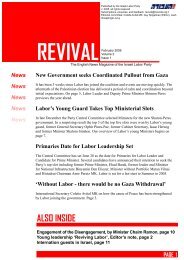Create successful ePaper yourself
Turn your PDF publications into a flip-book with our unique Google optimized e-Paper software.
The first official use of the Shield of David design can<br />
be traced back to the Emperor Charles IV who in 1354<br />
granted the Jewish community of Prague the privilege<br />
of displaying their own flag on state occasions. The<br />
banner in red and gold was emblazoned with a Magen<br />
David. The design soon began to appear in the city's<br />
synagogues, on books and other articles, as a printer's<br />
mark, and as the official seal of the Jewish<br />
community. However, aside from two tombstones<br />
(one of David Gans, the astronomer and historian),<br />
there is no other example of the Magen David being<br />
used on a grave stone prior to the eighteenth century.<br />
From Prague the symbol of the Magen David<br />
gradually spread throughout Bohemia, Moravia,<br />
Holland, Austria, and Germany and eventually to the<br />
rest of Western Europe. However, the symbol's<br />
migration eastward was much slower,<br />
With Jewish emancipation following the French<br />
Revolution, Jews began to look for a symbol to<br />
represent themselves comparable to the Cross used by<br />
their Christian neighbors. They settled on the<br />
hexagram rather than the ancient symbol of Judaism,<br />
the Menorah. Precedent for such a choice already<br />
existed with the steadfast growth and acceptance of<br />
the design by many Jews and non-Jews alike. A few<br />
generations earlier, for example, in seventeenth<br />
century Vienna, the Jewish quarter had been separated<br />
from the Christian quarter by a boundary stone<br />
inscribed with a Cross on one side and a Shield of<br />
David on the opposite side. It was the first instance of<br />
the six pointed star being used to represent Judaism as<br />
a whole rather than an individual community. By the<br />
end of the eighteenth century the adoption of the<br />
hexagram by Jewish communities was almost<br />
complete (it had finally made its way to Eastern<br />
Europe and to Oriental Jewry), and almost every<br />
synagogue and ritual object bore the design. Indeed,<br />
by 1799 the hexagram had already appeared as a<br />
Jewish sign in anti-Semitic cartoons.<br />
In 1822 the popularity of the Magen David reached a<br />
new pinnacle when the design was incorporated in the<br />
Rothschild family coat of arms when they were raised<br />
to nobility by the Austrian Emperor. Other prominent<br />
figures followed the Rothschild example. Thus, the<br />
famous poet Heinrich Heine, in his letters from Paris<br />
to the Augsburger Allegemeine Zeitung, signed his<br />
correspondence with a Magen David instead of his<br />
name.<br />
Even greater impetus for the general acceptance of the<br />
Magen David as representing Jews and Judaism came<br />
with its adoption by the First Zionist Congress in<br />
1897 as the symbol of the movement and the central<br />
motif on its flag. Theodor Herzl, the father of modern<br />
Political Zionism, also used the design on the<br />
masthead of the first issue of Die Welt, the Zionist<br />
movement's journal. With the growing oppression of<br />
the Jews in twentieth century Europe and the rise of<br />
anti-Semitic totalitarian states the Magen David<br />
became a beacon of hope, strength, and unity for<br />
world Jewry. The Nazis, in turn, used the Shield of<br />
David as a badge of shame. Nevertheless, like the<br />
Phoenix of fable, the Magen David has risen from the<br />
ashes of the Holocaust as a symbol of Jewish unity<br />
and identity, and as a national emblem of the State of<br />
Israel.<br />
JF<br />
Continued from page 12<br />
NORMAN BERDICHEVSKY<br />
The Dilemma of the Israeli Arabs<br />
Israel will lose nothing if it accepts the principle of<br />
equal rights and equal responsibilities for individuals<br />
rather than for communities. However, this does not<br />
mean comprising the “national identity” of the state<br />
with its Jewish character and symbols.<br />
Undoubtedly there were many more educated Arab<br />
(and Druze, Circassian) individuals who could have<br />
been appointed to the post of Israeli representative at<br />
the UN or European Union than the party hacks who<br />
were selected as part of the coalition politics<br />
stemming from Israel's proportional representation<br />
system. Even among states whose religious or<br />
national-linguistic identity is represented by a<br />
dominant group such as Hindus in India, the President<br />
is a Moslem and until recently in Iraq, the Foreign<br />
Minister, Tariq Aziz was a Christian.<br />
After 50 years of procrastination, there has been one<br />
Israeli Arab appointed to the level of ambassador (to<br />
Finland) and an Israeli Druze (Walid Mansour) to<br />
Vietnam. The Arab is Adib Hassan Yihye, a lecturer at<br />
24 JEWISH FRONTIER<br />
Summer 2004




